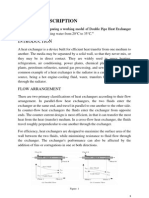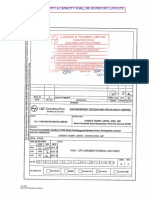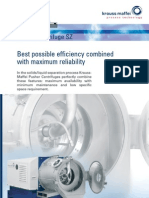Project Heat and Mass Transfer
Project Heat and Mass Transfer
Uploaded by
Areen Emilia Faizlukman JerryCopyright:
Available Formats
Project Heat and Mass Transfer
Project Heat and Mass Transfer
Uploaded by
Areen Emilia Faizlukman JerryOriginal Description:
Copyright
Available Formats
Share this document
Did you find this document useful?
Is this content inappropriate?
Copyright:
Available Formats
Project Heat and Mass Transfer
Project Heat and Mass Transfer
Uploaded by
Areen Emilia Faizlukman JerryCopyright:
Available Formats
Heat Transfer BKF 2422 Mini Project
APPENDICES
Introduction
Literature Review
Design Problem
Discussion
Conclusion
14
Reference
14
1|Page
Heat Transfer BKF 2422 Mini Project
INTRODUCTION
A heat exchanger is an equipment in which heat exchange takes place between two fluids that
enter and exit at different temperature. The main function of heat exchanger is to either remove heat
from a hot fluid or to add heat to the cold fluid. In this heat exchanger designation, we study only the
counter-current flow. Both the hot and cold fluids flowing in the opposite direction. In this case study,
we focused on the 1-2 shell and tube heat e x c h a n g e r .
We had chosen oil as hot fluid while water as cooling fluid. The decision to use thermal oil as a heat
transfer medium can be based on many reasons but one of the major incentives is the use on a nonpressurised system. Steam systems operate under pressure and are subject to statutory and regulatory
requirements due to the inherent risk from pressure and the increased cost of installation and routine
insurance inspection requirements. Besides, thermal oils are much more thermally stable, non-toxic and
able to create higher temperatures at atmospheric pressure, than their former counterparts. As a result
many companies are investigating the use of the technology in their heat transfer processes.
Thermal oils allow the use of low pressure heat transfer systems to achieve high temperatures
which would otherwise have necessitated high pressure steam systems. Steam systems are subject to
statutory and regulatory requirements due to the inherent risk from pressure and the increased cost of
installation and routine insurance inspection requirements.
2|Page
Heat Transfer BKF 2422 Mini Project
These are the table properties of the oil:
3|Page
Heat Transfer BKF 2422 Mini Project
LITERATURE REVIEW
Heat exchanger is a devices that is vital in industries. These industries such as power production,
food industry, manufacturing industry and a lot more other industries. It has various types. It funtioned
according to its uses. Heat exchanger is used to transfer thermal energy between two or more fluids,
between a solid surface and a fluid at different temperatures and in thermal contact. In heat
exchangers, heat transfer between fluids through a separating wall or into and out of a wall.
Now, we will discuss about shell and tube heat exchanger. There are several types of shell and
tube of heat exchanger. For example shell and tube heat exchanger (1,2), 1 represent number of shell
and 2 represent number tube. So, there is many other shell and tube heat exchanger with different
number of shell and tubes. It is built with bundle of round tubes in a large cylindrical shell with the tube
axis parallel to the shell. That is because it used to transfer the heat between the two fluids. The fluid
flows inside the tubes and other fluid flows across and along the tubes. It consists of tubes, shells, frontend head, rear-end head, baffles and tubesheets. It is used as oil-coolers, power condensers, preheaters
in power plants and also steam generators in nuclear power plants. The most common types of shell and
tube heat exchanger are U-tube design and floating-head type.
There are a lot of advantages using shell and tube heat exchanger. The advantages are the
configuration gives a large surface area in a small volume, a good shape for pressure operation, uses of
well-established fabrication techniques, can be constructed from a wide range of materials, easily
cleaned and a well-established design procedures. It is also cheap except for U-tube design which is
quite expensives.
4|Page
Heat Transfer BKF 2422 Mini Project
DESIGN PROBLEM
Problem statement Water, at a flow rate of
, needs to be heated from 302.59 K to 305.93 K.
Lubricant oil is available at 330.37 K. A typical shell and tube heat exchanger will be used. The plant
manager recommends that the minimum temperature approach should be at least 10 K. He also
recommends using 20 BWG carbon-steel tubing with a pressure drop not exceeding 10 psig (0.67 atm)
for either the shell or tube side.
5|Page
Heat Transfer BKF 2422 Mini Project
DISCUSSION
(Data from Pennel Power Engineering Corp.)
Fluid A
0.00905
330.37
319.26
Fluid B
0.01
302.59
305.93
(All data express in Excel Spreadsheet Data)
Fluid A (hot fluid)
= Oil
Fluid B (cooling material)
= Water
6|Page
Heat Transfer BKF 2422 Mini Project
First and foremost, we need to determine whether Fluid A should be in shell or tube pass. Stream
allocation is an important decision in heat exchanger design. This decision can impact the heat
exchanger life; can also make the difference between higher and lower maintenance costs. Plus, it can
also have a high impact on the thermal performance the heat exchanger. From the properties, Fluid A
which is oil should be place in shell pass. This is because it has lower flow rate compare to Fluid B
(cooling material). Furthermore, we need to cool down the temperature of Fluid A, so it is more prefer
for Fluid A place inside shell pass.
Next, we need to determine whether the flow configuration is co-current or counter-current. Based on
our research, we choose counter-current for the flow configuration. For your information, a heat
exchanger can have several different flow patterns. Counter-flow, parallel flow, and cross-flow are
common heat exchanger types. A counter-flow heat exchanger is the most efficient flow pattern of the
three. It leads to the lowest required heat exchanger surface area because the log mean temperature
drop is the highest for a counter-flow heat exchanger. Thats why counter-current flow configuration is
more preferable in this heat exchanger design.
For cooling material which is Fluid B to cool down Fluid A, we had chosen water. This is due to water is a
universal solvent and can act the best as cooling material. Besides, water is inexpensive and non-toxic.
The advantages of using water cooling over air cooling include water's higher specific heat capacity,
density, and thermal conductivity. This allows water to transmit heat over greater distances with much
less volumetric flow and reduced temperature difference.
7|Page
Heat Transfer BKF 2422 Mini Project
Properties of Fluid B
(All properties are evaluated at average temperature of Fluid B)
T(K)
p(kg/m3)
(Pa.s)
Cp(kJ/kg.K)
k(W/m.K)
Npr
299.9
996.4
4.183
0.00086
0.6109
5.89
304.26
995.7323
4.1830
0.0008
0.6177
5.3479
311
994.7
4.183
0.000682
0.6283
4.51
(Data is calculated in Excel Spreadsheet Data)
Calculate the Heat Load
Heat balance:
Since
We can calculate for
Therefore, heat load,
8|Page
Heat Transfer BKF 2422 Mini Project
Estimated overall heat transfer coefficient (
) for this heat exchanger design
For Heavy oil as hot fluid, and water as cooling material, the overall heat transfer coefficient is around
.
th
(From journal and textbook, Geankopolis, 4 Edition)
Thus, we decide to take
as overall heat transfer coefficient,
Calculate the true mean temperature difference
is the heat exchanger
Before we calculate true mean temperature difference, we must first calculate Log mean temperature
difference and determine its Fouling factor.
Log Mean Temperature Difference (LMTD)
9|Page
Heat Transfer BKF 2422 Mini Project
Based on value Y and Z, we can determine the
th
(from textbook Geankopolis, 4 Edition)
Thus, now we can easily find the true mean temperature,
Calculate the heat transfer area using the estimated overall heat transfer coefficient,
10 | P a g e
Heat Transfer BKF 2422 Mini Project
Calculate The Tube-Side Shell And Shell-Side Transfer Coefficients.
For fluid B :
T average(K)
p(kg/m3)
Cp(kJ/kg.K)
304.26
995.7323
4.1830
0.0008
k(W/m.K)
Npr
0.6177
5.3479
Assumption :
1. Fixed tube plate type
2.
0.025 m OD tubes (14 BWG) on 1.25 square pitch (PT)
3.
Tube length (Lt) = 0.609m (the tube length is increased from 0.406m)
4.
1 shell pass-6 tube pass (tube passes is increased to 6 from 2)
5.
Tube ID= 0.021m
6.
Flow area per tube=0.0352m2
7. 1 shell 6 tube
11 | P a g e
Heat Transfer BKF 2422 Mini Project
no of tube = 715.4485 / (0.025)(0.609) = 323
NRe = 4mo (np/nt ) / di = 4(0.01)(6/323)/ (0.021)(0.00081000) = 14.07
u = NRe k / di k = 14.07(0.8)/0.021(995.7323) = 0.538 m/s
Tube-shell heat transfer coefficient =
JH = hi di /k (k ck / kk) -(1/3)
42= hi (0.04) / 0.6177 (0.8(4.183)/0.6177) -(1/3)
hi = 4676.33 W/m2 .K
Side-shell coefficient =
Assumption :
ID= 0.028m, OD=0.032
De = 4 (Pt2 - /4 do2) / do = 4(12 - /4 (0.0322) )/ (0.032) = 39.7567
As = /4 (Di2) = /4 (0.028 2) = 6.158 10-4 m2
NRe = ms De / As s = 0.0095 (39.7567) / 6.15810-4 (0.8) = 490.66
haD/k =1.86 (NRe NPr D/L ) (1/3)
ha (0.032) / 0.6177 = 1.86 (490.66 (5.3479)(0.032/ 0.609 ))(1/3)
ha =185.48 W/m2.K
12 | P a g e
Heat Transfer BKF 2422 Mini Project
Calculate Uo cal and heat transfer area.
Uo cal =1 / [ 1/ ho +Rdg +Ao /Ai ((Do-di) /2kw) + Ao /Ai (1/hi) + Ao /Ai Rdk ]
Uo cal = 1/ [ 1/4676.33 +0.0002 + ( (0.0252)/ (0.0212)) {(0.025/12)-(0.021/12)}/2(0.6177)} + (
(0.0252)/ (0.0212)) (1/185.48) + ( (0.0252)/ (0.0212)) 0.0009 = 152.31
Error = 152.3 - 180 / 180 = 15.4%
Heat transfer area = Q /Uo cal
= 139.7122 / (152.3 (19.9038)) = 0.046 m2
To reduce error :
1. Reduce the pressure drop.
2. Take the value in the correct table.
Estimation heat transfer coefficient = 2430.9 W/m2 K.
13 | P a g e
Heat Transfer BKF 2422 Mini Project
CONCLUSION
From the case study, we had already made a choice on heat exchanger plant design. We also had
calculated the entire projects requirement. Although it is quite difficult to find company with their
specification heat exchanger, we finally have come out with this final report. All calculation is state and
all details we have attached it in Excel Spreadsheet data. Therefore, we can conclude that the objective
of this Mini Projects which is to apply knowledge of mathematics, science, engineering fundamentals
and an engineering specialization to the solution of complex engineering problems, to - Identify,
formulate, research literature and analyzed complex engineering problems reaching substantiated
conclusions using first principles of mathematics, natural sciences and engineering sciences, and to Design solutions for complex engineering problems and design systems, components or processes that
meet specified needs with appropriate consideration for public health and safety, cultural, societal, and
environmental considerations are successfully achieved.
REFERENCE
1) http://www.power-eng.com/articles/print/volume-114/issue-2/features/supplementalcooling.html
2) http://web.mit.edu/16.unified/www/SPRING/propulsion/notes/node131.html
3) Transport Process Textbook, Geankopolis, 4th Edition.
4) http://en.wikipedia.org/wiki/Heavy_crude_oil
5) http://www.brighthubengineering.com/hvac/62410-heat-exchanger-flow-patterns/
14 | P a g e
You might also like
- MBA Research ProposalDocument8 pagesMBA Research Proposalaku01198788% (8)
- Waiting For A Sales Renaissance in The Fourth Industrial RevolutionDocument12 pagesWaiting For A Sales Renaissance in The Fourth Industrial RevolutionTemato pro10No ratings yet
- Mass and Energy Balance of Ice Manufacturing PlantDocument11 pagesMass and Energy Balance of Ice Manufacturing Planteric labordoNo ratings yet
- Biruk Endale Design On Heat Exchanger-1Document32 pagesBiruk Endale Design On Heat Exchanger-1nigus gereziherNo ratings yet
- Synopsis Heat ExchangerDocument9 pagesSynopsis Heat ExchangerJitesh PaulNo ratings yet
- NST Fellowship ProposalDocument4 pagesNST Fellowship ProposalMd. Badrul Islam100% (2)
- Heat Exchanger 4Document9 pagesHeat Exchanger 4Karter KhelaNo ratings yet
- Heat Transfer Lab ManualDocument60 pagesHeat Transfer Lab ManualSMIT CHRISTIAN100% (1)
- Temperature and Expanding Radius of PipeDocument2 pagesTemperature and Expanding Radius of PipeShreyasGadkariNo ratings yet
- Analysis of Forced Draft Cooling Tower Performance Using Ansys Fluent Software PDFDocument13 pagesAnalysis of Forced Draft Cooling Tower Performance Using Ansys Fluent Software PDFesatjournals100% (1)
- Topic3 Ventilation Part 2Document51 pagesTopic3 Ventilation Part 2Anisha AdzihanNo ratings yet
- Applications and Operations That Involve Steam-Jet EjectorsDocument12 pagesApplications and Operations That Involve Steam-Jet Ejectorsbhalchandrak1867No ratings yet
- Air Pollution and Control Engineering (Autosaved)Document58 pagesAir Pollution and Control Engineering (Autosaved)Mithun Santhosh YuvarajanNo ratings yet
- Heat Transfer Project Report 1Document11 pagesHeat Transfer Project Report 1api-336536037No ratings yet
- Boiler - FinalDocument73 pagesBoiler - FinalMohit GauttamNo ratings yet
- DM PlantDocument8 pagesDM Plantvimalsoni2212No ratings yet
- Cooling Towers: Mass Transfer Operations IiiDocument26 pagesCooling Towers: Mass Transfer Operations IiiChristian FuentesNo ratings yet
- Tors Assignment 2Document14 pagesTors Assignment 2Leonard ZammitNo ratings yet
- Review On Eutectic Freeze Crystallization and Auxiliary Cooling SystemsDocument35 pagesReview On Eutectic Freeze Crystallization and Auxiliary Cooling Systemsflyhigh7100% (1)
- Final Mini Project ReportDocument30 pagesFinal Mini Project ReportRatheesh SNo ratings yet
- Biomass (Rice Straw) Fired BoilerDocument9 pagesBiomass (Rice Straw) Fired BoilerSnehashis MaityNo ratings yet
- Design Shell and TubeDocument15 pagesDesign Shell and TubeAhmad MaskurNo ratings yet
- Ultrasonic Machining (USM) : Dr. Harlal Singh MaliDocument11 pagesUltrasonic Machining (USM) : Dr. Harlal Singh MaliPrashant Singh SankhalaNo ratings yet
- Commercial Scale Membrane Distillation For Solar Desalination PDFDocument6 pagesCommercial Scale Membrane Distillation For Solar Desalination PDFMohamed HammamNo ratings yet
- Energy Saving in Spray Drying ProcessDocument15 pagesEnergy Saving in Spray Drying ProcessJorge OsorioNo ratings yet
- Plate Heat ExchangerDocument10 pagesPlate Heat ExchangerPrabhavJainNo ratings yet
- Conceptual Diagram of A Plate and Frame Heat Exchanger02Document9 pagesConceptual Diagram of A Plate and Frame Heat Exchanger02sai thesisNo ratings yet
- Membrane Pre TreatmentDocument10 pagesMembrane Pre Treatmentadalcayde2514No ratings yet
- Fossil Fuel Steam GeneratorDocument33 pagesFossil Fuel Steam Generatorchaiya sonwongNo ratings yet
- EjectorsDocument5 pagesEjectorsJaykumarNo ratings yet
- The Design and Testing of A Continuous Effluent Sterilization System For Liquid WasteDocument8 pagesThe Design and Testing of A Continuous Effluent Sterilization System For Liquid Wastepeyman mahinsaNo ratings yet
- 4 Chapter Four Chemical Reaction and CombustionDocument90 pages4 Chapter Four Chemical Reaction and CombustionMohamed AbdelaalNo ratings yet
- MVRDocument8 pagesMVRBagus HutomoNo ratings yet
- API 70 R1 UV Spares - V1Document1 pageAPI 70 R1 UV Spares - V1Malik MentuNo ratings yet
- Evaporation 2 PDFDocument58 pagesEvaporation 2 PDFEli John NovelaNo ratings yet
- Electrostatic Precipitator (ESP)Document20 pagesElectrostatic Precipitator (ESP)avmurugan87No ratings yet
- Dry Scrubber (Approval) PDFDocument12 pagesDry Scrubber (Approval) PDFkrishnaNo ratings yet
- Heat Exchanger Effectiveness PDFDocument5 pagesHeat Exchanger Effectiveness PDFfrilofhNo ratings yet
- Vacuum PumpsDocument6 pagesVacuum PumpsTurbojetmanNo ratings yet
- Combustion Engineering-52949589Document23 pagesCombustion Engineering-52949589Justine BoqsNo ratings yet
- Design and Construction of A Domestic Passive Solar Food DryerDocument8 pagesDesign and Construction of A Domestic Passive Solar Food DryerMerwin Michael FernandesNo ratings yet
- Shell and Tube Heat ExchangerDocument12 pagesShell and Tube Heat ExchangerZi ChingNo ratings yet
- Experiments and Modeling of Bubble Column Dehumidifier PerformanceDocument11 pagesExperiments and Modeling of Bubble Column Dehumidifier PerformanceAl-Kawthari As-SunniNo ratings yet
- A Review To Optimize The Heat Transfer Rate and Increase The Efficiency of The Cooling TowerDocument6 pagesA Review To Optimize The Heat Transfer Rate and Increase The Efficiency of The Cooling TowerEditor IJRITCCNo ratings yet
- Heat Exchangers: DR Ali JawarnehDocument46 pagesHeat Exchangers: DR Ali Jawarnehprasanthi100% (1)
- Iiche Online Internship - 2020 Petroleum Refinery Engineering - Batch 1 Assignment 1 - White Paper 1Document3 pagesIiche Online Internship - 2020 Petroleum Refinery Engineering - Batch 1 Assignment 1 - White Paper 1Shivam Kumar RaiNo ratings yet
- Sedimentation 2Document14 pagesSedimentation 2Habib AbdullahNo ratings yet
- Flash Tank PDFDocument19 pagesFlash Tank PDFMufita RamadhinaNo ratings yet
- Noniterative Design of Multiple Effect Evaporators Using Excel Add InsDocument10 pagesNoniterative Design of Multiple Effect Evaporators Using Excel Add InsGalang Hanif AbdulahNo ratings yet
- Magnetic RefrigerationDocument20 pagesMagnetic RefrigerationVineet DubeyNo ratings yet
- Biogas Boiler: Thermal Efficiency: Biogas Has A Lower Calorific Value Than Natural Gas, andDocument2 pagesBiogas Boiler: Thermal Efficiency: Biogas Has A Lower Calorific Value Than Natural Gas, andLeonardo GalardoNo ratings yet
- WorkDocument43 pagesWorkAkash GundaleNo ratings yet
- Rotary Filters Verteil InformationDocument12 pagesRotary Filters Verteil InformationManali PatilNo ratings yet
- Centrifugal Pump Practical ReportDocument21 pagesCentrifugal Pump Practical ReportSlindile HlambisaNo ratings yet
- Steam Boiler Litt ReviewDocument4 pagesSteam Boiler Litt ReviewToMem33% (3)
- What Sets The SaltMaker Apart 1Document10 pagesWhat Sets The SaltMaker Apart 1Furi Sri RahimahNo ratings yet
- Good Cip SystemDocument7 pagesGood Cip SystemThanneeru Naga RajuNo ratings yet
- 2 - Pusher Centrigufe Krauss MaffeiDocument4 pages2 - Pusher Centrigufe Krauss Maffeizamburitti100% (1)
- Sugar Research & Innovation, Queensland University of Technology, AustraliaDocument10 pagesSugar Research & Innovation, Queensland University of Technology, AustraliaTeena AlawadNo ratings yet
- Air Pollution ControlDocument35 pagesAir Pollution ControlPraveen YadavNo ratings yet
- Energy Audit at HETERO LABS UNIT HETERO DRUGS UNIT 6 1706212997Document74 pagesEnergy Audit at HETERO LABS UNIT HETERO DRUGS UNIT 6 1706212997varadhpharmaNo ratings yet
- Energy Optimization in Parallel or Cross Feed Multiple-Effect EvaporatorDocument12 pagesEnergy Optimization in Parallel or Cross Feed Multiple-Effect Evaporatorkishna009No ratings yet
- Water Treatment Plant Performance Evaluations and OperationsFrom EverandWater Treatment Plant Performance Evaluations and OperationsNo ratings yet
- Heat TransferDocument9 pagesHeat TransferAjinkya MoreNo ratings yet
- ESI Calculation ModelDocument11 pagesESI Calculation ModelVikas BansalNo ratings yet
- IAAD Master Transportation 2016engDocument13 pagesIAAD Master Transportation 2016engApoorv GargNo ratings yet
- Habit 3 Steven CoveyDocument52 pagesHabit 3 Steven CoveyRheinhart PahilaNo ratings yet
- Faith Aira PassionDocument26 pagesFaith Aira PassionChino Paolo ChuaNo ratings yet
- Digital Signal Processing Lecture Notes 2 PageDocument5 pagesDigital Signal Processing Lecture Notes 2 PageLungelo MkhwanaziNo ratings yet
- Assessment of Ones Teaching PracticeDocument27 pagesAssessment of Ones Teaching PracticeMarvin CayagNo ratings yet
- Integrating Geography Information System in TeachiDocument7 pagesIntegrating Geography Information System in TeachiGeomatique GestionNo ratings yet
- VW 91101 enDocument14 pagesVW 91101 enIsabel SierraNo ratings yet
- Tutorial 3 - AASTUDocument4 pagesTutorial 3 - AASTUeyobNo ratings yet
- Diary FormatDocument1 pageDiary FormatPhilippe CANTORIA (SHS)No ratings yet
- 10 1 1 741 5971Document11 pages10 1 1 741 5971Mariel A. HaliliNo ratings yet
- Velocity Limit For Design of PipelineDocument9 pagesVelocity Limit For Design of PipelinevinaymeconNo ratings yet
- MPH DissertationDocument7 pagesMPH DissertationBuyingCollegePapersCanada100% (1)
- Basic Experiments of Home Automation Using ESP8266, Arduino and XBeeDocument5 pagesBasic Experiments of Home Automation Using ESP8266, Arduino and XBeerobert.cesarNo ratings yet
- Sta. Cecilia College: Third Periodical ExaminationsDocument3 pagesSta. Cecilia College: Third Periodical ExaminationsTitser JeffNo ratings yet
- Tourism Celebration Script 2.0Document5 pagesTourism Celebration Script 2.0Jenipe Rondina CodiumNo ratings yet
- Research Paper On N Queen ProblemDocument7 pagesResearch Paper On N Queen Problemxvrdskrif100% (1)
- Chapter 2 PerceptionDocument56 pagesChapter 2 PerceptionMind KindNo ratings yet
- Test 1: Solve The Following Problems (10 Points Each) Problem 1Document6 pagesTest 1: Solve The Following Problems (10 Points Each) Problem 1jethro ganeloNo ratings yet
- Operator'S Manual: Navtex ReceiverDocument67 pagesOperator'S Manual: Navtex Receiverluqman PBNo ratings yet
- Ssc-Je: General Intelligence & ReasoningDocument20 pagesSsc-Je: General Intelligence & ReasoningAkhilNo ratings yet
- Present Perfect Social Media CompreDocument19 pagesPresent Perfect Social Media CompreWendy ChanNo ratings yet
- Ptu PaperDocument2 pagesPtu PaperYour Tech My TechnologyNo ratings yet
- Shared-Memory Model and Threads: Intel Software CollegeDocument35 pagesShared-Memory Model and Threads: Intel Software CollegeAhmed KhazalNo ratings yet
- LARCE TERASAKI E250-SCJ Data SheetDocument3 pagesLARCE TERASAKI E250-SCJ Data SheetCamilo SepulvedaNo ratings yet
- Seahorse Company Profile - Q4Document29 pagesSeahorse Company Profile - Q4Phạm KiênNo ratings yet

























































































